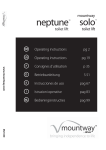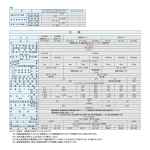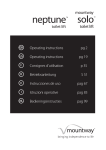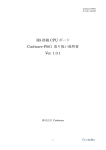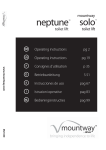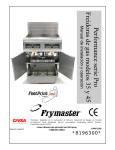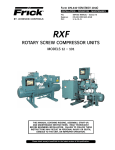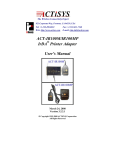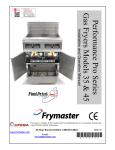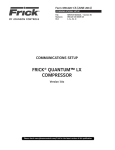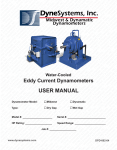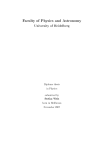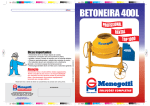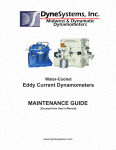Download Condenser Specifications XLC 85
Transcript
Condenser Specifications XLC 85 CoolWare v7.1.1 Registered To: Johnson Controls - USA - Eric Ramon Customer Name End User Name Project Reference Item Data 11/9/2007 Atmospheric Pressure Elevation Condenser 14.70 psi 0 ft OPERATING CONDITIONS Refrigerant Wet Bulb Temp Condenser Temp Condenser Pressure R717 Actual Capacity 78.0 °F Catalog Capacity 95.0 °F 181.0 psig 844.3 mbh 1249.5 mbh SPECIFICATIONS Data Airflow No Fans Fan Motor Refrigerant Charge Pan Heater Pump Data 14600 cfm Spray 1 Motor (1) 7.5 hp 91 lbm kW 90.0 gpm 1.0 hp Noise Noise at 25 ft Noise at 50 ft Noise at 100 ft Unit Weights 59.0 dBA Shipping 53.0 dBA Operating 47.0 dBA Heaviest Section Dimensions Height Width Length Volume Required 3960 lbm 5070 lbm 3285 lbm Remote Sump Data 106.9 in Water In 72.5 in Drain 117.0 in Volume Required 9.6 ft3 ERRORS AND WARNINGS York Refrigeration - Frigid Coil 13711 Freeway Drive, Santa Fe Springs, CA 90670 Phone:(562)921-4310 Fax:(562)921-6412 York Refrigeration - Imeco 1590 Dutch Rd., Dixon, IL 61021 Phone(815)288-3859 Fax:(815)288-1665 Disclaimer: the information contained in this program is subject to change without notice. Frick reserves the right to final verification of all rating results. 2.5-MPT 4-FPT 95.0 gal Form S140-600 IOM (NOV 2007) INSTALLATION - OPERATION - MAINTENANCE File: Replaces: Dist: SERVICE MANUAL - Section 140 S140-600/NOV 2005 3, 3a, 3b, 3c XL EVAPORATIVE COOLING PRODUCTS S140-600 IOM (NOV 07) Page 2 XL EVAPORATIVE COOLING PRODUCTS TABLE OF CONTENTS NOTE: Installation, operation, maintenance, and repair of this equipment should only be accomplished by qualified personnel. Failure to follow this note may result in improper installation and operation of the equipment and personal injury. Frick's XL Condensers are designed to ensure energy efficient operation and years of dependable, trouble-free service. To maximize service life, it is important to follow the recommended installation, operation, and maintenance procedures outlined in this manual. Be sure to follow the Recommended Maintenance Table and read the detailed instructions of each procedure. Care taken to follow these instructions will directly affect the satisfactory operation and reliability of the system. TABLE OF CONTENTS Preface ................................................................................................................................ 3 Job Inspection...................................................................................................................... 3 Transit Damage Claims ........................................................................................................ 3 Unit Identification ................................................................................................................. 3 Safety Requirements ........................................................................................................... 3 Installation Tools .................................................................................................................. 4 General Information ............................................................................................................. 4 Installation Instructions ........................................................................................................ 5 Optional Vibration Isolator - Mounting Instructions .............................................................. 9 Final Assembly Details ...................................................................................................... 10 Operating Instructions........................................................................................................ 11 Maintenance Instructions ................................................................................................... 12 Water Treatment............................................................................................................. 12 Suggested Maintenance Intervals ................................................................................. 12 Fans ............................................................................................................................... 15 Operation and Maintenance .............................................................................................. 15 Operation and Maintenance Schedule .............................................................................. 16 Recommended Spare Parts .............................................................................................. 17 FIGURES Figure 1a. XLC I-Beam Location.......................................................................................... 4 Figure 1b. XLP I-Beam Location .......................................................................................... 4 Figure 2. Platform Layout ..................................................................................................... 5 Figure 3a. XLC Pan Coil Section Rigging ............................................................................ 5 Figure 3b. XLC Fan Section Rigging .................................................................................... 5 Figure 4a. Mastic Placement For Blower Mounting ............................................................. 6 Figure 4b. Blower Assembly Mounting Instructions ............................................................. 6 Figure 5. XLC Unit Assembly with Desuperheater ............................................................... 6 Figure 6. Platform Layout ..................................................................................................... 7 Figure 7a. XLP Fan Section Rigging (All models except 1570-2 and 1660-2 — 1880-2) ............. 7 Figure 7b. XLP Fan Section Rigging (Models 1570-2 and 1660-2 — 1880-2) ............................ 7 Figure 7c. XLP Coil Section Rigging .................................................................................... 8 Figure 8. XLP Mastic Location and Unit Assembly .............................................................. 8 Figure 9. Vibration Isolator Feet ........................................................................................... 9 Figure 10. Vibration Isolator Rails ...................................................................................... 10 Figure 11. Eliminator .......................................................................................................... 10 Figure 12. XLC Spray Header Nozzle Orientation ............................................................. 13 Figure 13. XLP Spray Header Nozzle Orientation ............................................................. 13 Figure 14. Sheave Alignment ............................................................................................. 14 TABLES Table 1. XLC Foundation Layout Dimensions ...................................................................... 5 Table 2. XLP Foundation Layout Dimensions ...................................................................... 7 Table 3. Rigging Cable Lengths ........................................................................................... 8 SAFETY PRECAUTION DEFINITIONS NOTE: Indicates an imminently hazardous situation which, if not avoided, will result in death or serious injury. Indicates a potentially hazardous situation or practice which, if not avoided, will result in death or serious injury. Indicates a potentially hazardous situation or practice which, if not avoided, will result in damage to equipment and/or minor injury. Indicates an operating procedure, practice, etc., or portion thereof which is essential to highlight. XL EVAPORATIVE COOLING PRODUCTS GENERAL INFORMATION PREFACE S140-600 IOM (NOV 07) Page 3 UNIT IDENTIFICATION This manual has been prepared to advise the owner and service personnel of recommended INSTALLATION, OPERATION, AND MAINTENANCE procedures recommended by Frick for XL Evaporative Cooling Equipment. Read the following instructions completely prior to installation. These instructions provide you with the information needed for safe, proper installation, operation, and maintenance of your new product. Care taken during the installation will directly affect the satisfactory operation and reliability of the system. ® To ensure correct installation and application, the units must be properly selected and connected to an appropriately designed and installed system. The engineering plans, piping layouts, etc. must be detailed in accordance with the best practices and local codes, such as those outlined in ASHRAE literature. All units should be rigged and installed as outlined in this manual. These procedures should be thoroughly reviewed prior to the actual rigging operation to acquaint all personnel with the procedures to be followed. It is also important that these units be applied to a properly controlled refrigeration system. Your authorized Frick representative should be consulted for expert guidance on questions pertaining to installation and application. If at any time during the review of this document or installation/operation you require assistance, please call your local Sales representative. JOB INSPECTION PLEASE RECORD THE FOLLOWING INFORMATION FOR FUTURE REFERENCE: Model No. Serial No. Date Received Immediately upon arrival at the job site, the unit should be inspected to ensure all required parts have been received and are free of shipping damage prior to signing the Bill of Lading. Unpack all items and check against shipping lists for any possible shortages. If any part appears to be missing, contact your Frick representative. The following parts should be inspected: • Sheaves & Belts • Bearings • Bearing Supports • Fan Motor(s) • Fan(s) and Shaft(s) • Coils • Water Distribution System(s) • Spray Water Pump(s) • Strainer(s) • Float Valve Assembly(ies) • Eliminators • Interior and Exterior Surfaces • Belt Guard(s) • Motor Hood(s) • Miscellaneous Items: If required for field assembly, the following parts will be packaged and usually placed inside the pan section: Mastic, Bolts, Nuts, Washers, and any accessory items. TRANSIT DAMAGE CLAIMS NOTE: When inquiring about the unit or ordering repair parts, provide the MODEL and SERIAL NUMBERS from the data plates. SAFETY REQUIREMENTS XL unit installation, operation, and maintenance – involves heavy rotating machinery operating at high speed and high voltage. Normal operations and maintenance procedures may require working at elevations, enclosed space entry, or use of hand and power tools. With these considerations, safety must be the top priority in all activities with this evaporative cooling product. Frick recommends that every client analyze and develop an installation-specific safety regime that takes into account such variables as specific site/system features, personnel qualifications, hazard identification, etc. The following elements of operational safety are recommended for inclusion in every client’s XL condenser safety plan/requirements: Electric – Configure all power switches and controls to provide an open, safe circuit before and during maintenance procedures, until the unit is cleared by management for normal on-line operations. For extended shutdowns it is recommended that a qualified technician remove fuses from “fused-disconnect panels” or otherwise open the circuit in an accepted, secure manner. Fans – All fan covers, guards, and shaft retainers (if any) must be in place before applying power to an XL condenser. Always disengage and lock out power before allowing interior inspections. To prevent foreign objects from being drawn into rotating fan blades, never allow operation with hatch off/open. Enclosed space inspections – Inspections of condenser coil, drift eliminators, etc., requires machinery lockout and the use of a “lookout buddy” at a minimum. Consult your internal safety policy and OSHA requirements for additional safety rules/procedures. All claims must be made by the consignee. This is an ICC requirement. Request immediate inspection by the agent of the carrier and be sure the proper forms are executed. Vibration and noise – Discontinue or stop machinery that emits unusual vibration and noise. The source must be investigated (and apparent discrepancies corrected) before testing or placing the unit back in operation. Contact Parts and Warranty Department to report damage or shortage claims. Wet Surface Precautions – Poorly maintained/wetted machinery requires care to avoid electrical shocks from in- S140-600 IOM (NOV 07) Page 4 XL EVAPORATIVE COOLING PRODUCTS INSTALLATION adequate/loose field wiring/connections. All personnel must lock out and tag machinery before working on the condenser. Proper safety precautions such as the use of insulating soles/gloves and a trained “lookout buddy” are indispensable. Ice formation in cold weather can present fall/slip hazards. Icing safety procedures should be mandatory when the daily ambient temperature falls below 40°F (4.4°C). Each beam should be sized in accordance with standard engineering practices, 55% of the operating weight of the unit as a uniform load on the beam, allowing for a maximum deflection of 1/360 of the length, not to exceed 1/2 inch. Water Chemistry – All evaporative-cooled condensers operate on principles that encourage biological growth in the recirculating water unless effective treatment is applied. Recirculating water must be periodically analyzed for biological culture plate counts. XL units should not be operated without an effective biological treatment program. NOTE: Emergency “shock” treatment with chemical biocides may upset the unit’s appropriate pH range (creating an excessively corrosive environment for the materials of construction) and may expose operators to strong chemicals that are corrosive or otherwise dangerous if mishandled (see water treatment comments in the CHEMICAL TREATMENT section of MAINTENANCE). Field Piping Considerations for XL Unit Installation – All IDC units require strongly supported and anchored field piping. No field piping is to be supported by the XL itself. Wind loading, temperature variation, etc., must be considered to allow for movement between the tower, building, optional vibration isolator/rails, and field piping. A qualified cooling system design engineer should provide final field-piping plans and specifications. Before finalizing piping installation plans, it is recommended that related plans for cooling system/plant expansion be discussed with your field piping/system designer and Imeco sales representative. Incorporating pipe openings/sizes now allows for easier installation in the future. Figure 1a - XLC I-Beam Location On Unit INSTALLATION TOOLS To complete the installation of the XL Evaporative Condensers, the following tools are needed: • Drift pins • 8-foot straight edge • Level • Assorted open-end wrenches • Socket set • Belt tension gage • Tape measure GENERAL INFORMATION All XLC and XLP models should be anchored directly to concrete pads or concrete piers. These units may also be supported on structural “I” beams as outlined below. The Centrifugal Fan XLC units are designed to be supported by two structural “I” beams, one located under each end of the unit and running the full width of the unit (See Figure 1a). The Vane Axial Fan XLP units are designed to be supported by two structural “I” beams, one located under the front and one under the rear of the unit, running the full length of the unit (Figure 1b). As an alternate, the structural “I” beams may run the full width of the unit. Please refer to the unit foundation drawings furnished by Frick for each specific sales order for complete details. Figure 1b - XLP I-Beam Location On Unit XL EVAPORATIVE COOLING PRODUCTS INSTALLATION All units have 13/16 inch diameter mounting holes for mounting to the beams. The beams should be supported so that the unit is level. Shims between the beams and the unit should not be used, as this will not provide adequate support. If vibration isolation is required, whether furnished by Frick or by others, the isolators must always be mounted below the structural “I” beams. Continuous support of unit, as described above, must be provided. S140-600 IOM (NOV 07) Page 5 XLC CENTRIFUGAL FAN UNITS XLC units are shipped in two pieces: the pan/coil section and the fan section. The first step of the installation is to mount the pan/coil section on the structural beams and bolt it to the beams. The rigging of the two pieces is shown in Figures 3a and 3b. For minimum cable length, see Table 1. INSTALLATION FOUNDATION LAYOUT INFORMATION FOR XLC UNITS Beams and/or piers should be sized in accordance with standard engineering practices, 55% of the operating weight as a uniform load. Beam deflection should not exceed the larger of 1/360 of span or 1/2 inch. In Figure 2, “A” represents the overall length of one cell and “B” represents the center lines of the mounting holes in the unit. The dashed lines show the location of the structural beams to which the unit is mounted. Table 1 XLC FOUNDATION LAYOUT DIMENSIONS MODEL XLC 25 through XLC 40 XLC 43 through XLC 55 XLC 58 through XLC 90 XLC 95 through XLC 128 XLC 130 through XLC 185 XLC 195 through XLC 250 XLC 285 through XLC 385 XLC 410-2 through XLC 500-2 XLC 570-2 through XLC 770-2 C 27.25 38.75 27.25 38.75 57.25 80.25 80.25 D — — — — — — — MIN. CABLE LENGTH 6 ft. 6 ft. 11 ft. 11 ft. 11 ft. 12 ft. 17 ft. A 57 57 117 117 117 117 177 B 54 54 114 114 114 114 174 117 114 80.25 258 12 ft. 177 174 80.25 378 17 ft. Figure 3a - XLC Pan/Coil Section Rigging Figure 3b - XLC Fan Section Rigging Figure 2 - Platform Layout S140-600 IOM (NOV 07) Page 6 XL EVAPORATIVE COOLING PRODUCTS INSTALLATION The second step of installation is to mount the fan section to the pan/coil section as follows: 1. Remove guards from both ends and remove the vertical guard between the blowers to provide access to mounting holes. Also, remove the motor housing access panel. 2. Take mastic from parts box and place on coil section unit body as shown in Figure 4a. 3. Lower fan section to pan/coil section unit body so that the blower support on the fan section rests on the flanged edge of the top fan mounting panel on the pan/coil section unit body. Move the fan section to the pan/coil section unit body until all mounting flanges are touching. (Figure 4b) 4. On each blower, install bolts with a flat washer under both the bolt and nut. 5. Tighten all bolts connecting fan and pan/coil Sections together before removing rigging. 6. Align the V-belt drive and check tension in the belts using the procedures in the section labeled "Fan Drives and Belts" in this manual. Figure 4b - Blower Assembly Mounting Instructions 7. Replace all guards and the motor hood access panel. NOTE: When provided, mount desuperheater on top of unit using holes provided in the mounting bracket. Note that some units are shipped with the desuperheater factory mounted. Assemble gas piping between desuperheater and condensing coils after final positioning of the desuperheater. Inter-gas piping is to be furnished by others. Figure 5 - XLC Unit Assembly With Desuperheater Figure 4a - Mastic Placement For Blower Mounting XL EVAPORATIVE COOLING PRODUCTS INSTALLATION FOUNDATION LAYOUT INFORMATION FOR XLP UNITS Beams and/or piers should be sized in accordance with standard engineering practices, 55% of the operating weight as a uniform load. Beam deflection should not exceed 1/360 of span, or maximum of 1/2 inch. In Figure 6, “A” represents the overall length of one cell and “B” represents the center lines of the mounting holes in the unit. The dashed lines show the location of the structural beams to which the unit is mounted. S140-600 IOM (NOV 07) Page 7 TABLE 2 XLP FOUNDATION LAYOUT DIMENSIONS MODEL S90 thru S175 S185,S190,S200,S205 S180, S195 S210 thru S270 M155 thru M280 M285 thru M430 M810-2 thru M960-2 ML235 thru ML345 L350 thru ML520 ML820-2 thru ML1040-2 L290 thru L415 L435 thru L700 L810-2 thru L830-2 L870-2 thru L1400-2 XL355 thru XL530 XL535 thru XL805 XL785, 830 – 940 XL830-2 thru XL1060-2 XL1070-2 thru XL1650-2 XL1570-2 and XL1660-2 thru XL1880-2 A B C D 145 141 57.5 — 145 141 68.5 — 92 92 92 92 92 92 112 112 112 112 137 137 137 137 137 — — 378 — — 446 — — 314 446 — — — 314 446 137 514 121.87 117.87 177 173 177 173 145 141 211 207 211 207 145 141 211 207 145 141 211 207 145 141 211 207 245 241 145 141 211 207 245 241 E F 1.625 0.75 2.125 2 Figure 6 - Platform Layout INSTALLING XLP SINGLE LENGTH UNIT XLP units are shipped in two pieces, the pan/fan section and the coil section. The first step of the installation is to mount the fan/pan section on the structural beams with bolts. The rigging of the two pieces is shown in Figures 7a through 7c. For cable lengths, see Table 3. Figure 7a - XLP Fan Section Rigging (All models except 1570-2 and 1660-2 through 1880-2) Figure 7b - XLP Fan Section Rigging (Models 1570-2 and 1660-2 through 1880-2) S140-600 IOM (NOV 07) Page 8 XL EVAPORATIVE COOLING PRODUCTS INSTALLATION Table 3 RIGGING CABLE LENGTHS XLP Model Figure 7c - XLP Coil Section Rigging The second step of the installation is to mount the coil section as follows: 1. Some units are shipped with the fan guards in the pan section for shipping purposes. In these cases, remove fan guards from pan section and install on the front of the unit before joining fan and coil sections. Min. Cable Length S 14 ft M - 2 Fan 13 ft M - 3 Fan 17 ft ML - 2 Fan 15 ft ML - 3 Fan 20 ft L - 2 Fan 16 ft L - 3 Fan 21 ft XL - 2 Fan 17 ft XL - 3 Fan 22 ft 4. Remove rigging and install four 1/2" bolts with flat washers under both the bolt and nut. NOTES: 1. Use spreaders and blocking to protect casing from possible damage caused by slings. 2. Remove eliminator tie straps and eliminators as necessary to access lifters. 2. Take mastic from parts box and place on the top of the fan & pan section as shown in Figure 8. Be sure to apply two layers of mastic across each end of the unit as shown. 3. Mount coil connection toward access door unless specified differently on product drawing. 3. Lower the coil section to the fan & pan section with rigging attached to all eight lifters. For extended lifts, use lifters and safety slings (Figure 7c). Use drift pins in bolt holes to ensure proper alignment. See Figure 8. 4. When provided, mount desuperheater on top of unit using the holes provided in the mounting bracket. Assemble piping between desuperheater and coil after final positioning of desuperheater. Figure 8 - XLP Mastic Location And Unit Assembly XL EVAPORATIVE COOLING PRODUCTS INSTALLATION S140-600 IOM (NOV 07) Page 9 OPTIONAL VIBRATION ISOLATOR MOUNTING INSTRUCTIONS Vibration isolators, purchased as an option, are used to minimize transfer of forces due to vibration/dynamic loading to or from unit. To install the isolator feet and rails, refer to Figure 9 and Figure 10 respectively and follow these instructions: ISOLATOR FEET 1. Refer to the submitted foundation layout drawing for the correct location of each isolator and support beams. 2. Place the isolators in their proper location and attach the bottom plate to the building support steel by means of bolting or welding. 3. Set the unit support beams on top of the isolators and attach them to the top plate by means of bolting or welding. Figure 9 - Vibration Isolator Feet 4. Lower the first section of the unit onto the beams, taking care not to overload any one corner. ISOLATOR RAILS Do not attempt to move the unit laterally with the weight on the isolators. If it is necessary to move the unit, remove the weight from the isolators by raising the unit before moving. Failure to follow this procedure could result in damage to the isolator. 5. Attach the unit to the beam by means of bolting or welding. 6. Continue to attach the remaining unit sections per the instructions on the previous pages and complete piping, wiring,etc. NOTE: Ridged connections between the unit and building structure shall not be permitted when vibration isolators are used. Use flexible connections that allow for vibration and noise isolation. 7. Loosen the vertical restraint jam nuts to the end of the restraint bolts. 8. When the unit is completely installed and operating, turn the leveling bolts counterclockwise several complete turns on each isolator until the blocking channel can be removed by hand. It will be necessary to alternate between isolators in order to uniformly raise the unit. Do not attempt to place all the weight on any one isolator, but distribute the load proportionally. 9. After the unit is level, tighten the vertical restraining nuts finger tight, then back off one half turn. Lock each nut with the jam nuts provided. 1. Refer to the submitted foundation layout drawing for the correct location of each isolator rail. 2. Place the isolator rail assemblies in their proper location and attach the bottom plate to the building support steel by means of bolting or welding. 3. Lower the first section of the unit onto the rails, taking care not to overload any one corner. Do not attempt to move the unit laterally with the weight on the isolators. If it is necessary to move the unit, remove the weight from the isolators by raising the unit before moving. Failure to follow this procedure could result in damage to the isolator. 4. Attach the unit to the isolator rail by means of bolting or welding. 5. Continue to attach the remaining unit sections per the instructions on the following pages and complete piping, wiring, etc. NOTE: Ridged connections between the unit and building structure shall not be permitted when vibration isolators are used. Use flexible connections that allow for vibration and noise isolation. 6. Temporarily remove all vertical locknuts from hold-down bolt. 7. When the unit is completely installed and operating, turn the leveling nuts clockwise several complete turns on each isolator until the shim can be removed by hand. It will be necessary to alternate on each isolator in order to uniformly raise the unit. Do not attempt to place all the weight on any one isolator, but distribute the load proportionally. 8. After the unit is level, replace all vertical locknuts on holddown bolts and fasten finger tight. S140-600 IOM (NOV 07) Page 10 XL EVAPORATIVE COOLING PRODUCTS INSTALLATION Figure 10 - Vibration Isolator Rails FINAL ASSEMBLY DETAILS 1. ELIMINATOR PLACEMENT Check the placement of the eliminator sections on the top of the unit to ensure that all eliminator sections are properly interlocked and that there are no openings present which will allow the escape of water droplets. Eliminator tie-down straps can be removed after assembly is complete. Check the orientation of the eliminator sections to ensure "RIGHT SIDE UP" as shown in Figure 11. J. Check fans and pumps for correct rotation and electrical hook-up. K. See the Operation and Maintenance Manual for new belt run-in procedures. 3. BREAKING IN THE GALVANIZED SURFACES A proper break-in procedure should be followed for water treatment to allow the galvanized surfaces to break in or passivate. This allows the galvanized surfaces to form a self-protecting zinc carbonate layer. A qualified water treatment specialist can provide specific details, but following are some guidelines. • Clean all wetted surfaces. • Touch up scratches in the galvanizing with cold galvanized paint. Figure 11 - Eliminator • Keep the water as close neutral (pH 7.0) as possible. Must be between 6.5 and 7.5 at all times during the break-in period. 2. INSPECTION • Avoid cleaning chemicals in pH ranges above 8.0 and below 6.0. Prior to start-up, the following services, which are described in detail in the operating and maintenance manual, must be performed: • Operate under minimal load during the break-in period. When the unit is installed, the water can be circulated through the unit before the refrigerant piping is connected to begin the passivation process. A. Inspect general condition of unit. B. Inspect fan, motors, bearings, drives, and locking collars for condition and alignment. C. Check belt tension and condition per the maintenance manual instructions. D. Lubricate all bearings. E. Inspect spray headers and heat transfer section. F. Check makeup valve and sump water level. G. Check fans and guards for obstructions. H. Clean and flush pan and strainer. I. Rotate fan(s) by hand to ensure rotation without obstruction. • After the break-in period, typically 30-45 days, begin regular water treatment procedures. Again, local water treatment professionals will be best equipped to create a water treatment program designed to meet the specific needs of the installation. Proper start-up procedures and scheduled periodic maintenance will prolong the life of the equipment and ensure trouble-free performance for which the unit is designed. DO NOT ATTEMPT ANY INSPECTION AND/OR MAINTENANCE UNLESS THE ELECTRICAL SUPPLY HAS BEEN COMPLETELY DISCONNECTED AND LOCKED OUT. XL EVAPORATIVE COOLING PRODUCTS OPERATION OPERATION S140-600 IOM (NOV 07) Page 11 COLD WEATHER OPERATION Frick Evaporative Condensers are suitable for most cold weather applications when supplied with proper capacity control and freeze protection. ® Frick Evaporative Condensers remove heat from the fluid circulating in the coil by recirculating water over the outside of the coil and blowing air up through the wetted coil. The water that is recirculated over the outside of the coil is stored in the pan section at the bottom of the unit, and is pumped over the coil through spray nozzles by the spray pump mounted on the end of the unit. The fans are located on the side of the XLC Centrifugal Fan Units in the dry entering air stream and are driven by a motor that is mounted on top of the fan section. The fans on the XLP Vane Axial Fan Units are located above the pan in the pan/fan section in the dry entering air stream and are driven by motors that are located below the fans. ® A common application for Vane Axial units is to cycle the operating fans to achieve capacity control. Typically, the fans are cycled off as capacity drops and finally, the pump is shut off. In cold weather operation, Frick recommends that the pump should be the first item shut off to achieve capacity control. By running the unit dry in cold applications, the unit’s drive is protected from ice formation. Ice forms when the spray water causes moist air to migrate out of idle fans where it condenses and freezes on cold metal surfaces. ® The coolers are designed to provide maximum capacity when both the spray system and the fans are running, and only partial capacity when either the spray system or the fans are running alone. A practical method of capacity control is to cycle the fan and spray pump motors with a thermostat or pressure switch that senses the fluid leaving the unit. Care must be taken, however, to cycle the fans off first, then the spray pump. This enables the solids left behind to be washed into the pan, by the spray water, where they can be bled off to the drain. As long as the Evaporative Condensers are in operation with a load, with capacity control dampers, the recirculating pan water will not freeze. However, the pan water must be protected when Evaporative Condensers are under a “no load” condition with fans and spray pumps off. An indoor remote sump and pump is the best means of avoiding pan water freezing in an idle Evaporative Condenser. With this remote sump system, the pan water is always drained to the indoor remote sump whenever the recirculating water pump is stopped. When provided, capacity control dampers are mounted in the discharge throat of the fans on the XLC units or on the air discharge of the XLP units for closer control of fluid temperature or pressure. These dampers are controlled by a modulating damper actuator and a remote bulb-type temperature or pressure controller. The sensing bulb of the controller should be installed in the fluid piping leaving the unit, and the controller should be wired to the damper actuator as shown on the appropriate wiring diagram. The damper actuator contains an end switch that should be used to turn off the fan motor when the dampers are fully closed. Because of the Evaporative Condenser location or space limitations, a remote sump installation may be impractical. In such cases, supplementary heat must be supplied to the pan water. The Evaporative Condenser will then need to be furnished with an electric pan heater. This heater will provide sufficient heat to keep the spray water in the pan from freezing when the unit is not running. The heater is controlled by a thermostat that senses the pan water temperature, and is factory set at 42°F. The heater is protected by a low water cutout switch that prevents the heater from operating if the pan water level is below the heater element. In addition to protecting the pan water, all exposed water piping, including the pump suction line, pump, pump discharge piping (up to the overflow connection), and the make-up water lines, should be traced with electrical heat tape and insulated. Some Evaporative Condenser installations will permit all spray water to be drained from the pan during cold weather operation. This permits dry operation of the Evaporative Cooler or Condenser when the load and ambient temperatures are low. Units provided with positive closure discharge dampers are designed to reduce heat loss from the unit when it is not in operation by eliminating the chimney effect. The dampers are operated by an “On-Off” damper actuator, and are positioned closed when the spray pump motor is off, and open when the spray pump motor is on. The actuator should be wired as shown on the appropriate wiring diagram. Units that require year-round operation in a freezing climate should be equipped with an electric pan water level control package. This package ensures a constant water level without adjustment and also maintains very close control of the pan water level. The system consists of a weather-protected electric float switch with stilling chamber mounted on the pan section and a weather-protected solenoid valve mounted on the water makeup connection. When this system is used, it replaces the standard mechanical water makeup valve. S140-600 IOM (NOV 07) Page 12 XL EVAPORATIVE COOLING PRODUCTS MAINTENANCE MAINTENANCE Frick Evaporative Condensers accomplish condensing by evaporating water from the spray water system at the rate of two gallons per minute per one million BTU’s per hour of heat removed, or three GPM per 100 tons of refrigeration. When this water evaporates, however, the solid impurities remain and must be flushed from the system to prevent a scale build up on the coil and casing. This is accomplished by a bleed-off valve located on the spray pump discharge line which bleeds off an equal amount of water to that which is evaporated. chemical concentration of the water outside of the acceptable ranges listed above. ® For conditions where the original water hardness is very high or a large number of airborne contaminants may enter the spray water, a higher bleed-off rate or chemical treatment may be required to prevent scale buildup on the coil. Consult your local water treatment company for recommendations. WATER TREATMENT If the condition of the water is such that constant bleed-off will not control scale and/or control the recirculating water pH level within the acceptable range listed below, chemical treatment may be required. If a water treatment program is to be used, please consult a competent water treatment specialist, but use the following guideline as a minimum requirement: • Chemicals must be compatible with zinc galvanic protection and maintained in proper concentration to be compatible with all materials of construction. • The circulating water must be maintained between 6.5 and 8.0 pH at all times. Below 6.5, corrosion and/or accelerated consumption of protective zinc material will occur. When the pH reaches 8.3 or above, white rust may occur which will require passivation as discussed below. • Maintain total dissolved solids below 1000 parts per million. • Maintain alkalinity hardness between 100-300 parts per million. • Maintain chlorides below 200 parts per million. • Maintain sulfates below 250 parts per million. • Chemicals should be fed into the recirculated water, but not into the cold water sump, on a continuous metered basis to avoid localized high concentrations which may cause corrosion. Batch feeding of chemicals does not provide adequate control of water quality and may lead to harmful concentration levels. Batch feeding is not recommended. • Acid water treatment may be used but requires additional controls and significant caution. Acids are very harmful to galvanized surfaces, so the resulting pH levels must be closely monitored. Unfortunately, some water supplies provide highly alkaline water that can lead to white rust and must be tempered to more moderate pH levels. When acid treatment is required, sufficient feed controls must be put into place to maintain the pH of the water that comes into contact with the condenser components (coil, walls, sump, etc) within the aforementioned acceptable range. It is recommended that the chemical feed for acid treatment be done in a tank, such as a remote sump tank, that allows complete diffusion of the chemical before it is pumped to the unit. In addition to the chemical feed controls, regular inspections of feed valve and chemical levels should be included in the preventative maintenance plan to avoid • The unit interior including the condenser walls above and below the coil, the coil and the sump basin should be inspected regularly. Signs of corrosion or excessive scale will highlight problems in the water treatment system. These must be addressed quickly to prevent significant damage to the protective galvanized surface. • The use of simple bleed-off or chemical treatment for control of scale or corrosion does not preclude the need to control biological contamination. Treatment with biocide is a necessary part of required water treatment. Upon initial commissioning of the equipment, passivation of the galvanized surfaces is required. As discussed above, when the pH levels are elevated during normal operation, the passivation process discussed below will be required. Passivation allows a galvanized surface to develop its protective layer of zinc carbonate and is an important part of the water treatment process. During passivation, operate the condenser as follows: • Clean all surfaces. • Maintain pH levels as close to 7.0 as possible. Do not allow the pH to fall below 6.5 or to rise above 7.5 at any time during passivation. • Phosphate treatments can assist in the passivation process. • Operate under minimal load. When the unit is installed, the water can be recirculated through the unit before refrigerant piping is connected to begin the passivation process. • Maintain these conditions for a period of 30-45 days. • NOTE: if start-up does not allow for minimal load conditions for the required duration, the passivation can be repeated during the fall or winter following start-up. The following paragraphs contain specific and critical maintenance operations required for the components that make up the water circulation system. SUGGESTED MAINTENANCE INTERVALS BLEED-OFF VALVE The bleed-off valve should be checked monthly to ensure that it is not blocked and that water is flowing as required. The valve should be set so that the bleed-off rate is two GPM per one million BTU’s/hour of heat removed (or per 83 tons of refrigeration). The bleed valve should always be open, unless the unit is controlled by a water treatmen t system. STRAINER The pan water strainer is located at the bottom of the pan section at the suction connection of the spray pump. The strainer should be cleaned monthly, or as conditions require, to keep it clean. The strainer is easily accessible through the access door. Do not operate the unit without the strainer. MAKEUP VALVE The pan water level is controlled by a float-actuated valve that is accessible through the access door. This valve should be checked monthly for proper operation and water level. The XL EVAPORATIVE COOLING PRODUCTS MAINTENANCE pan water level should be even with the centerline of the overflow when the unit is not running. This will prevent the pump from cavitating when the spray system is in operation. The water level is easily adjusted by loosening the wing nut on the valve and raising or lowering the ball to maintain the proper level. The recommended operating pressure for the water makeup valve is 15 to 20 PSI. MOISTURE ELIMINATORS The moisture eliminators are located on top of the unit and prevent losses of the spray water due to water being entrained in the air stream as it passes through the unit. The eliminators should be checked monthly to remove any obstructions that may be trapped between the blades and to ensure proper positioning. WATER DISTRIBUTION SYSTEM The spray nozzles are accessible by moving the eliminators in sections from the top of the unit (DO NOT OPERATE UNIT WITHOUT ELIMINATORS). The spray nozzles are large orifice, cleanable type. For XLC units, the nozzles should be checked monthly to see that the spray pattern is complete and even. Figure 12 shows the nozzle orientation in the spray headers and the spray direction. Figure 12 - XLC Spray Header Nozzle Orientation S140-600 IOM (NOV 07) Page 13 competitive nozzles. There is adequate space below the nozzle and a wide opening to allow large debris to be pulled out. Furthermore, with the fixed design, this nozzle is much more tolerant of harsh water conditions that lead to wear on moving nozzles NOTE: If the nozzle is removed for cleaning, always ensure that the initial orientation of the nozzle is maintained. See Figure 13. HEAT TRANSFER SECTION The coil should be examined monthly for signs of scale buildup, and any obstructions between the tubes should be removed. If there is evidence of scale buildup on the coil, check the bleed valve for adequate bleed-off. If the bleed-off valve is functioning properly, contact your local water treatment company for recommendations. FAN MOTOR AND SPRAY PUMP MOTOR The motors should be checked and/or lubricated every six months according to the motor manufacturers recommendations. FAN BEARINGS The fan bearings should be checked monthly and relubricated. The bearings should be lubricated while in operation, and the grease should be pumped in slowly until a slight bead forms around the seals. The grease will increase in temperature approximately 30°F during the relubrication. If the relubrication must be done while the bearings are not in operation, the grease capacity of each bearing on the XLC units is 7/8 ounce. The capacity on the XLP units is 3/8 ounce. The grease should conform to NLGI Grade Two consistency and should be free of any chemical impurities such as free acid or free alkali, dust, rust, metal particles or abrasives. Bearings should be lubricated with hand grease guns only. The following types of grease meet the above criteria: MOBILITH 22 MOBILUX #2 SHELL ALVANIA #2 UNIREX N2 TEXACO MULTIFAX #2 TEXACO PREMIUM RB FAN DRIVE AND BELTS The fan and motor sheaves and belt tension should be checked every month using the procedure outlined below. The sheaves should be tight on the shafts and should be aligned properly to minimize belt wear. The belts should be checked for wear along the edges as any irregularity will cause vibration. If the belts are not wearing evenly, the cause could be improper sheave alignment. Use the sheave alignment procedure below to check the sheave alignment. If any belt requires replacement, replace all the belts with a matched set, never one at a time. Figure 13 - XLP Spray Header Nozzle Orientation SHEAVE INSPECTION XLP units include low pressure, large orifice, clog-resistant nozzles. They features a large 2" connection that provides consistent, highly uniform water flow over a 6' square area of the coil bundle for maximum heat transfer. Check the sheaves for proper alignment, excessive corrosion, and wear or damage. Also, check the belt for excessive heat. If the belt is too hot to touch, then the sheaves may be damaged or need aligning. The large nozzle opening avoids the pitfalls of most other nozzles because most materials will pass straight through, avoiding much of the maintenance required by smaller, If the sheaves have excessive corrosion or are worn or damaged, they should be replaced. Check for sharp edges from wear or pitting of the grooves from corrosion. Either condition S140-600 IOM (NOV 07) Page 14 XL EVAPORATIVE COOLING PRODUCTS MAINTENANCE will promote belt wear and increase turnover. Groove gauges are also available to make it easy to see if the grooves are worn. If more than 1/32” of wear can be seen, the sheave should be replaced. Alignment of sheaves is extremely important for proper belt installation. The sheaves are aligned at the factory, but should be rechecked when new belts are installed. Use a straight edge to check alignment. Misalignment will show up as a gap between the outside face and the straight edge. Two conditions for misalignment exist, angular and parallel. To check both parallel and angular alignment, refer to the Figure 14 below and follow these instructions: 1. While placing a straight edge across the top of both motor and fan sheaves, check for four points of contact. 2. If a four-point contact is achieved, skip to the belt tensioning section. 3. To adjust for parallel misalignment, adjust the motor or fan shaft sheave. 4. To adjust for angular misalignment, adjust the motor mount adjustment nuts. This should also be done when tensioning the belt. 3. Move the motor until there is enough slack in the belt so it can be removed without prying. 4. Remove the old belts and inspect for unusual wear. Excessive wear may indicate problems with alignment or sheave damage. 5. Order replacement belts from the factory to ensure a proper belt equivalent. 6. Inspect other drive components such as bearings and sheaves for alignment, wear, lubrication, etc. 7. Clean the sheaves of debris before installing the new belt. 8. Install the new belts, align the drive, and tension the belts according to the procedures outlined here. Belt Tensioning Proper tension of a belt is very important to ensure maximum belt life. If too little tension is applied, the belt will slip. Too much tension can reduce belt and bearing life. It is not recommended that belt dressing is used when belt slippage occurs as this will damage the belt and cause premature failure. 1. Decrease the center distance between the sheaves so that the sheaves are somewhat loose. 2. Arrange the belts so the top and bottom spans have the same amount of sag. On vertical drives, arrange the belts so that each side has about the same amount of slack. 3. Apply tension to the belts by increasing the center distance between the sheaves until the belts are snug. 4. Operate the drive a few minutes to seat the belts in the sheave grooves. Observe the operation of the drive during start-up. A slight bowing of the slack side of the drive indicates proper tension. If the slack side remains taut during the peak load, the drive is to tight. Excessive bowing or slippage indicates insufficient tension. If the belts squeal as the motor comes on, they are not tight enough. The drive should be stopped and the belts tightened. NOTE: Do not overtighten the drive. If the above procedure still results in the belts squealing, but the belts are still taut on the slack side, a more precise method of testing the belt tension must be used. In this case, use a belt tensioning gage available from V-belt drive manufacturers or from factory. New Belt Run-In During initial startup of new belts, a belt run-in procedure is recommended. During start-up, follow these instructions: 1. During start-up, look and listen for unusual noise or vibration. Figure 14 - Sheave Alignment Belt Replacement When the decision is made to replace the belt, follow these steps: 1. Lock and tag out the starter. 2. After the power has been turned off and the motor guard removed, loosen the motor mount adjustment nuts. 2. After shutting down and locking out the starter, check the bearings and motor. If they feel hot, the belt tension may be too tight. 3. Run the drive under full load for 24 hours of continuous operation. Running the belts under full load allows them to seat themselves into the grooves. 4. After running the drive, check the tension of the belts. Retension to the recommended values. This run-in procedure will reduce the future need for re-tensioning and will help extend the life of the belts. XL EVAPORATIVE COOLING PRODUCTS MAINTENANCE FANS The fans should be checked monthly for any debris caught in the blades. Any foreign material that has accumulated between the blades should be removed to prevent air capacity reduction or an imbalance, resulting in excessive vibration. CASING FINISH The casing finish should be checked annually for corrosion that may have occurred due to the alternating wet and dry conditions. Any area that has corroded should be thoroughly cleaned and retouched with a zinc-rich compound. DISCHARGE CLOSURE DAMPERS/CAPACITY CONTROL DAMPERS/LINKAGES Under normal operating conditions, all bearings and other working joints must be lubricated every three months with a water-resistant grease which is rated for satisfactory performance at an ambient temperature range of -65°F to 250°F. All linkages should also be inspected monthly to ensure proper adjustment and flexibility. All linkage ball joints should be lubricated every three months with the same grease mentioned above. ELECTRIC PAN WATER LEVEL CONTROL PACKAGES Inspect Stilling Chamber for obstructions every three months. OPERATION AND MAINTENANCE INITIAL AND SEASONAL START-UP Before initial start-up or after a long shutdown period, the unit should be thoroughly inspected and cleaned. The start-up sequence should be: 1. Clean any debris from guards, fans, eliminators, heat transfer sections, and cold water sump. 2. Flush the cold water sump (with strainers in place) and drain to remove accumulated dirt. 3. Remove, clean, and replace sump strainers. 4. Turn the fan(s) by hand to ensure rotation without obstruction. 5. Check and, if necessary, adjust the fan belt tension. 6. Prior to seasonal start-up, lubricate the fan shaft and motor bearings. The ball bearings are factory lubricated, but should be relubricated if the unit has been sitting on site for more than a year before start-up. 7. On units furnished with discharge closure dampers and/or capacity control dampers, lubricate all bearings and other working joints and ensure proper linkage operation. 8. Check float-operated makeup valve to be sure it is operating freely. 9. Fill cold water sump with fresh water to the overflow level. 10. Adjust the float on the makeup valve to shut off the valve when the float is approximately 1.0" to 1.5" below the centerline of the overflow. 11. Start spray pump and check for the proper rotation as indicated by sticker on pump motor. On “Remote” installations where the unit pump was not furnished by the factory, a globe S140-600 IOM (NOV 07) Page 15 valve should be installed in the pump discharge line and the pump flow rate adjusted to the correct water flow. 12. Inspect spray nozzles and heat transfer section. 13. Check the locking collar on each fan shaft bearing and tighten if necessary. 14. Start the fan(s) and check for proper rotation as indicated by sticker on unit. 15. Check the voltage and current of all three legs of the fan and pump motors. The current should not exceed the rated service factor. After prolonged shutdowns, the motor insulation should be checked with a Megger Insulation Tester prior to restarting the motors. 16. Open the bleed line valve and adjust bleed to the recommended rate. 17. On units furnished with electric water level control packages, ensure that the stilling chamber is free of obstructions. AFTER 24 HOURS After 24 hours of operation under load, the following services should be performed: 1. Check unit for any unusual noise or vibration. 2. Check the operating water level in the cold water sump. Adjust if necessary. 3. Readjust fan belt tension if required. 4. Inspect spray nozzles and heat transfer section. OPERATION During operation, the unit should be inspected, cleaned and lubricated on a regular basis. The required services and recommended frequency for each are summarized in the Operation and Maintenance Schedule in this manual. SEASONAL SHUTDOWN The following services should be performed when the unit is to be shutdown for a prolonged period: 1. Drain the cold water sump and all piping that will be exposed to freezing temperatures. 2. Clean and flush the cold water sump with sump strainer in place. Leave the drain open so rain and melting snow will drain from the unit. 3. Clean the sump strainers and reinstall. 4. Lubricate the fan shaft and motor bearings, motor base and motor base adjusting screws. 5. Close shut-off valve in water make-up line and drain all exposed make-up piping. 6. Inspect the protective finish on the unit. Clean and refinish as required. 7. On units furnished with discharge closure dampers and/or capacity control dampers, lubricate all bearings and other working joints. 8. On units equipped with electric water level control packages, inspect stilling chamber to ensure it is free of any obstructions. S140-600 IOM (NOV 07) Page 16 XL EVAPORATIVE COOLING PRODUCTS MAINTENANCE OPERATION AND MAINTENANCE SCHEDULE TYPE OF SERVICE Inspect General Condition of Unit Clean debris from unit Clean and flush sump Clean sump strainer Check and adjust sump water level Inspect heat transfer section Inspect spray nozzles Check and adjust fan belt tension Check and adjust bleed rate Check operation of make-up valve Check unit for unusual noise or vibration Check fan bearing locking collars Check motor voltage current Lubricate fan shaft bearings Lubricate motor base adjusting screws Lubricate the fan and pump motors Check fan for rotation without obstruction Check fan and pump motor for proper rotation Drain sump and piping Inspect protective finish Lubricate capacity control and/or discharge closure damper bearings and working joints Inspect/adjust damper linkage Inspect electric pan water level control "stilling chamber" START-UP MONTHLY X X X X X X X X X X X X X X X X X X X X X X X X X X X X X EVERY 6 MONTHS SHUTDOWN ANNUALLY X X X X X X X X X X X EVERY 3 MONTHS X X X X X X X X X X X Before performing any maintenance or inspection, make certain that all power has been disconnected. SAFETY FREEZE PROTECTION Adequate precautions should be taken to safeguard the equipment and the premises from damage and the public from possible injury as appropriate for the installation and location of these products. These products must be protected against damage and/or reduced effectiveness due to possible freeze-up by mechanical and operating methods. Please refer to the Cold Weather Operation guidelines XL EVAPORATIVE COOLING PRODUCTS MAINTENANCE S140-600 IOM (NOV 07) Page 17 SPARE PARTS Frick recommends that the customer maintain the following spare parts “in stock” for the Evaporative Condenser. By maintaining this inventory of spare parts, continuous unit operation will be ensured. ® Contact your local Frick representative for pricing. The type and recommended stock level for each part is listed below. MODEL SERIAL NUMBER PART NUMBER RECOMMENDED STOCK LEVEL *FAN BELTS - __________________________________________________ One Set *FAN BEARINGS - _______________________________________________ One Set FAN BUSHING - ________________________________________________ One Set MOTOR BUSHING - _____________________________________________ One Set FAN SHEAVE - _________________________________________________ One Set MOTOR SHEAVE - ______________________________________________ One Set FLOAT VALVE ASSEMBLY - _______________________________________ One SPRAY NOZZLES - ______________________________________________ One Set *FAN MOTOR - _________________________________________________ One Set *SPRAY PUMP - ________________________________________________ One FAN SHAFT - ___________________________________________________ One * Parts noted to be considered as critical components to be stocked by customers to ensure continuous unit operation.


















